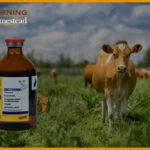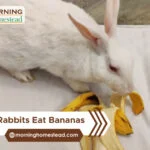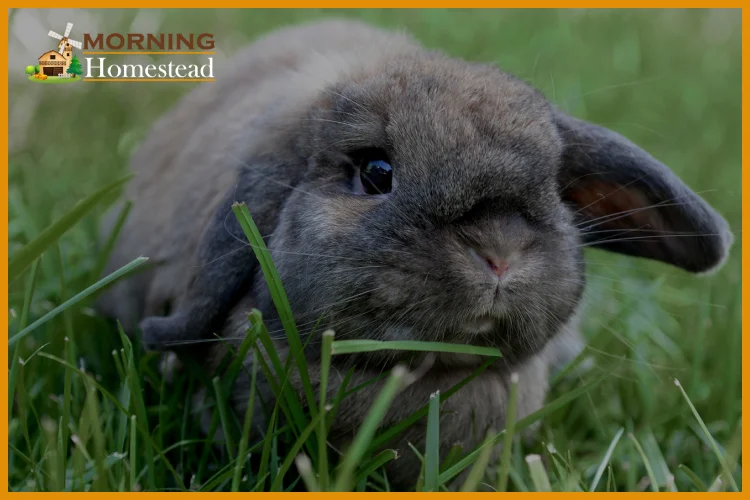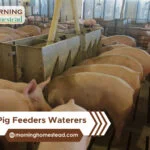Last Updated on June 15, 2023 by Georgie Smith
Cattle herds fed with one of the best round bale feeders consume on average 15 percent more hay per day. The same cattle gain 0.5 to .02 pounds more than the cows that eat unrolled and shredded forage.
During the winter farmers notice that their cattle are eating higher hay amounts when using a bale feeder. The cows consume more than regular ground feeding. That is easy to believe beings hay just lays on the ground with animals stomping on it in all weather conditions.
Soggy hay that has been on the wet ground is not going to attract your cattle to it. Round bale feeders are perfect for feeding your cattle while not losing money on damaged goods. Many farmers switched to round feeders vs. tossing feeding substances on the ground.
See Also:
- Top 5 Best Baler Twines for Maximum Production: Guide & Review [2023]
- Best Protein Tubs For Cattle And Why Your Herd Needs Them
- Best Liquid Fertilizer For Pastures That Are Safe for Livestock [2023]
Round bale feeders are not only cost-effective but there is a multitude of variables in each bale that permits serious flaws when pricing. Also, these variables combined with feeding waste make it cost-effective of feeding hay even more complicated.
The aim for the article is to enlighten consumers and farmers all about the best round bale feeders for cattle on the market. Our team at MorningHomestead is a business that offer guides and reviews on products.
We do this so that we can help you find the top, best-selling products on Amazon. However, we do not show favoritism to any product or manufacturer. The variety of feeders does not mean one type is better than the others. It simply means you have more choices to choose from for your farm.
Here’s the Best Round Bale Feeders For Cattle On Amazon:
TARTER GATE CO 3 Piece Round Bale Feeder
The first feeder on the list is a Tarter Gate, a three-piece round bale feeder. The feeder is an excellent choice for large cows that get themselves in tough situations for food. The item is simple to use, highly durable, and made right here in the United States. The feeder has a perfect five-star rating on Amazon by consumers just like yourself.
All you have to do is fill the feeder with hay and let the cattle and the feeder do their magic. This method of feeding is cost-efficient and effective for feeding.
The feeder is 1 x 44 x 34 inches and weighs 168 pounds. Click here to buy yours today and take advantage of free shipping. Help make mealtime more manageable for your herd to ensure they get plenty to eat to keep up their nutrition.
Buy from Amazon
Big Bale Buddy CO 3 Piece Round Lightweight Bale Feeder
The second item is from the company other than the design; they are identical. The Big Bale Buddy listed above is Blue with straight bars, and this feeder has slanted bars around the equipment. You get the same high-quality but just a little different in the design.
You can see the item by clicking here and getting yours delivered to your house for easy assembly. The feeder is 17.5 x 14.6 x 6.7 inches and weighs 99 pounds.
Buy from Amazon
Freedom Feeder Round Bale Hay Net
Third, we have a Buckwild Innovation hay ring cover. The roof of the system will attach directly to your hay ring. The cover is universal and the perfect item for protecting your hay when it is raining, sleeting or even snowing.
The cover connects to all cattle hay rings or a twelve-hoop ring for horses. The Freedom Cover turns your ring into a covered area for your cattle. It is perfect for feeders that do not have hay dust inhalation risks like feeders that are fully enclosed.
No more worry about your hay bales ruining from snow or rain. No more nasty soggy hay that just goes to waste because your cattle will not eat wet hay. If you are interested in this six-bar cover, click here. There is also more information for consumers.
Buy from Amazon
TEKE Ultra Ultra Slow Feed Hay Net Horse Pony Cattle Cow Feeder Net Mesh Hanging Bag 4.5mm Thickened Braided Nylon Mesh Bag
This TEKE Ultra Ultra slow feeder for hay and your cattle is the first mesh round bale feeder on the list. The good thing about having many varieties, is you get to choose which design fits your need the most. For instance, the three first items are designed to be a large system for many cattle. The high-quality feeder hay net bag is a perfect solution for a few cattle.
Just because this bale feeder design is cloth, do not let that confuse you. With numerous weaved knots along with two ropes joined together, you have a more useful and effective feeding. It also keeps the size suitable for your cattle.
With this slow feeder bag, you won’t need to worry if your cows will get something to eat without overeating or wasting the hay. It has a large capacity that is easy to carry from one site to the other and multi-hanging rings.
Click Here, and you will see the product, its features, and most of all a very simple way to buy one today.
Buy from Amazon
TECH EQUESTRIAN Slow Feed Hay Net 6×6 1 3/4 Hole
Last on the list is one other cloth bale feeder for cattle. Well, actually, it is not only for cattle. Horses, sheep, and other livestock can eat all they need and want by using one of these baler feeders. No more worrying about how much hay your cattle consume on a daily basis or how much gets tossed on the ground and left to ruin.
This item is Dupont Fiber, UV Treated, and has 1 ¾ inch square holes. If you need to feed several cows, you can because this feeder can handle 6 x 6 round bales. You can slow-feed your cattle to be healthier, and you will be happier spending less income on hay. If this type of bale feeder interests you, click here to make your purchase. One other great detail of this feeder is the universal design works for most livestock. Give it a try and see if it is the one for your farming needs.
There you have five of the leading products for Round Bale Feeders on the market today. Having a variety of different styles as well as capability make each of these high-quality and extremely useful for cattle farmers.
Buy from Amazon
Four Details to Know Before Buying a Round Bale Feeding For Your Cattle
With the cost as well as the convenience of technology today, finding the best farm equipment is not hard. Manufacturers saturate the market with high-end items and cheap pricing for items that are lower in quality. The following are tips you need to know before purchasing your feeder:
Size Does Matter :
Round hay bales cost is typically per bale. However, the amount of hay that is in bales will depend on the size and the density. One example is, imagine a round bale being a 5 x 6 in size. That means it will be five feet wide and six feet in diameter. Now, the price is $52.50 per bale. If this bale weighs 1,500 pounds, the cost will be equivalent to $70.00 per ton.
Now, take a 5 x 5 bale with an equal amount of density that weighs 1,046 pounds that cost $36.00 for each bale for a value of $70.00 per ton of hay.
A 4 x 5 bale with equal density weighs 833 pounds and would be priced at $29 per bale to equal that same $70 per ton of forage. Now, take a bale that is 4 x 5 with an equal density that weighs 833 pounds and cost $29.00 for each bale which equals the same $70.00 per ton for the hay.
As you can see, size and density are incredibly important to know. You want to make sure your hay is nutrient full, and not a bunch of forage added just for weight. Knowing the difference of how pricing works will save you money because you won’t be dishing at money for a product that is not high-quality.
Density Also Matters:
Density is the other area you need to know a lot about before buying or selling. The density of high-quality round bales of hay generally ranges between nine and twelve pounds for each cubic foot (lb./ft). In the previous example, we assume the round bales have a density of 10.61 pounds for each cubic foot.
However, the density of the bundles varies due to the type of hay, the skill of the baler, and adjustments to the baler. Round hay bales with a lower density weigh less. They are more difficult to handle and move around, and there is more loss while in storage.
If we use the 5 x 6 bale in the above example with it having a density of ten percent less (9.55/ft) and the bale weighs 1,350 pounds while a density 15 percent less (9.02ft)results in a weight of 1,275 pounds. If the bundle has a price tag of $52.50 per bale, the results per-ton will increase to $78.00 and $82.00 for the lower-density bundles we discussed above.
Subtract Your Storage Losses
Round hay bales have inevitably results in feeding and storage losses. Round bale loss varies tremendously depending on the feed management and storage of your hay bales. If you have well-managed storage and feeding you may limit your loses to ten percent.
However, when you combine feeding loss with storage loss, it often ranges to at least fifty percent or even higher. Round hay bales that are outdoors, uncovered on the ground, and fed by unrolled will experience the most significant loss. Those numbers typically scale to thirty to fifty percent.
Other situations such as feeding in open-sided feeders will also suffer significant losses. However, hay bales stored covered, indoors, off the ground, and unrolled for feeding in a cone-style feeder can keep loss down between five and fifteen percent.
Subtract All Feeding Losses
The hay amount actually consumed by your cattle drops dramatically with increased feeding and storage losses. At ten percent loss, the hay consumption is around 1,800 pounds per ton of hay. A twenty percent loss is 1,500 pounds and a 40 percent loss; the hay consumption is 1,200 pounds.
From the cost standpoint, these numbers make a huge difference. At a price of $70.00 per ton, feeding and storage losses will increase the hay price to $78.00 per ton at a ten percent loss. A $93.00 per ton cost at a 25 percent loss, and a $117.00 price per ton at a 40 percent loss.
Knowing how to scale your losses is one of the largest areas farmers miscalculate. You must know how to keep up with your storage loss as well as the hay your livestock consumes or ruin for various reasons.
*Helpful Tip* Feeding and storage losses together with low-density bales will increase the price of hay further.
The hay bale with low density discussed above, 5 x 6 weighing 1,275 pounds, and priced at $52.50 per bale results in a price of $91. 00 per ton and a ten percent loss- a $110.00 per ton and priced at $52.50 for each bale results in a cost of $91.00 for each ton and a ten percent loss or a $110.00 price per ton and a 25 percent loss, and last, at $137.00 per ton with a 40 percent loss.
As you can see, the combination of having a low bale density with high feeding and storing losses result is an actual cost that nearly doubles the quoted per-ton price of hay. That cost is the same whether you buy the feed or produce it yourself.
FAQs:
Q: Is it more cost effective to have my round bails wrapped as well as stored inside a barn?
A: With anything that can ruin the outdoors during winter and rainy seasons, you should store your round bundles in the best place possible to prevent waste and damage.
Q: Does it matter which style feeder to have for my cows?
A: Not really. Any of the ones mentioned in the guide will work perfectly for all hay balers.
Conclusion
As you can see, there is much more to baling and storing hay than most people realize. The Round Bale Feeder is something all hay farmers need on their list of “must-have equipment.” Due to storage loss and waste in the fields, farmers look for every way possible to save money. Now, you know how to figure out your loss which is a top priority.
Do you have experience with round bale feeders? If you do, we would sure love to hear from you. Leave us a message below and we will get back to you soon. Please “like and share “our work to help us continue to grow and help others.

![Best Round Bale Feeder For Cattle That Ensures Efficient Feedings [2023] Best Round Bale Feeder](https://morninghomestead.com/wp-content/uploads/2022/05/Best-Round-Bale-Feeder.jpg.webp)



